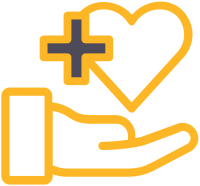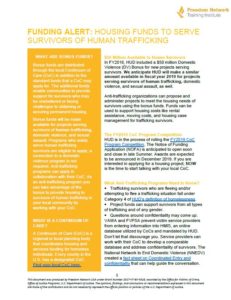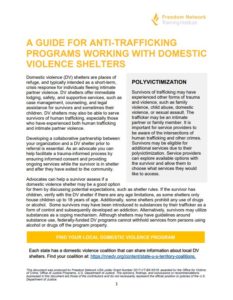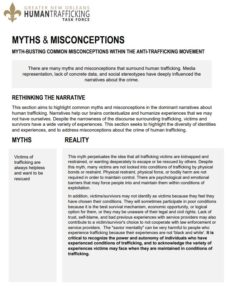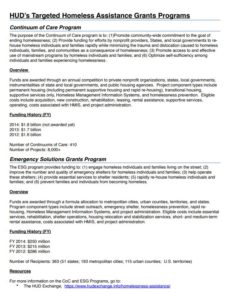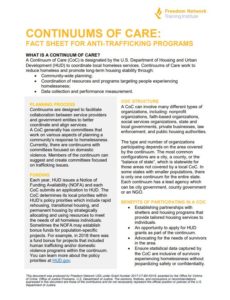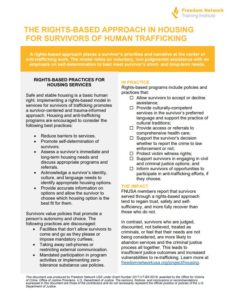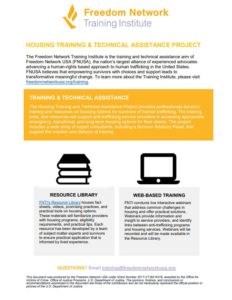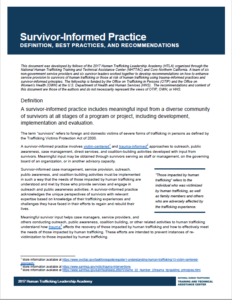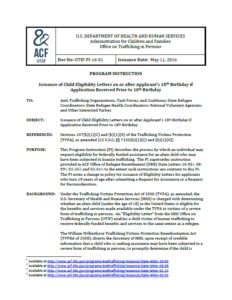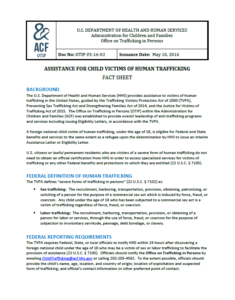The Resource Library includes fact sheets, promising practices, tools, templates, and training materials developed by subject-matter experts with direct experience working with survivors. Resource topics address current trends and challenges in the field.
Search Results 56 matching results for "Fact Sheets"
Funding Alert: Housing Funds to Serve Survivors of Human Trafficking
This fact sheet provides an overview of the HUD Continuum of Care Domestic Violence Bonus funds and tips for anti-trafficking organizations to apply for the funds.
Levels: Introductory
Material Types: Fact Sheets
Types of Trafficking: Labor Trafficking Sex Trafficking
Keywords: Housing
A Guide for Anti-Trafficking Programs Working with Domestic Violence Shelters
Domestic violence (DV) shelters are often utilized as emergency housing for survivors of trafficking. This guide provides anti-trafficking programs guidelines on assessing if a DV shelter is a good fit for a trafficking survivor and ideas for creating effective collaborations with DV programs.
Levels: Introductory
Material Types: Fact Sheets
Types of Trafficking: Labor Trafficking Sex Trafficking
Keywords: Domestic Violence Housing
Myths and Misconceptions
Resource developed by the Greater Louisiana Human Trafficking Task Force to bust the common myths and misconceptions within the anti-trafficking movement.
Levels: Introductory
Material Types: Fact Sheets
Types of Trafficking: Labor Trafficking Sex Trafficking
Keywords: Awareness
HUD’s Targeted Homeless Assistance Grants Programs
Fact sheet providing an overview of targeted homeless assistance grant programs available through the US Department of Housing and Urban Development.
Levels: Introductory
Material Types: Fact Sheets
Types of Trafficking: Labor Trafficking Sex Trafficking
Keywords: Housing Program Management
Continuums of Care
A Continuum of Care (CoC) is designed to coordinate and promote a local response to homelessness, including shelters and housing programs. Anti-trafficking organizations can benefit from collaboration with CoCs through new housing options for survivors and an expanded referral network. This fact sheet provides an introduction of what a CoC is and how anti-trafficking organizations can collaborate with their local CoC.
Levels: Introductory
Material Types: Fact Sheets
Types of Trafficking: Labor Trafficking Sex Trafficking
Keywords: Housing
The Rights-Based Approach In Housing for Survivors of Human Trafficking
Safe and stable housing is a basic human right. Implementing a rights-based model in services for survivors of trafficking promotes a survivor-centered and trauma-informed approach. This fact sheet explains the right-based approach in housing, the practice and impact.
Levels: Introductory
Material Types: Fact Sheets
Types of Trafficking: Labor Trafficking Sex Trafficking
Keywords: Case Management Housing
FNTI Housing TTA Project Flyer
The FNTI Housing Project provides training and technical assistance on access to housing to service providers working with survivors of human trafficking.
Levels: Introductory
Material Types: Fact Sheets
Types of Trafficking: Labor Trafficking Sex Trafficking
Keywords: Awareness Housing
Survivor Informed Practice
This fact sheet by the Office of Trafficking in Persons (OTIP) provides best practices to adopt a survivor centered model in service provision.
Levels: Introductory
Material Types: Fact Sheets
Types of Trafficking: Labor Trafficking Sex Trafficking
Keywords: Case Management Program Management Trauma Informed
Program Instructions: Child Eligibility Letters
This fact sheet describes the process by which an individual may request eligibility for federally funded assistance for an foreign-born child who may have been subjected to human trafficking.
Levels: Introductory
Material Types: Fact Sheets
Types of Trafficking: Labor Trafficking Sex Trafficking
Keywords: Case Management Foreign Nationals Legal Services
Demographics: Youth
Assistance for Child Victims of Human Trafficking
This fact sheet created by the Office of Trafficking in Persons (OTIP) provides users an understanding of benefit eligibility for victims of trafficking who are under the age of 18.


